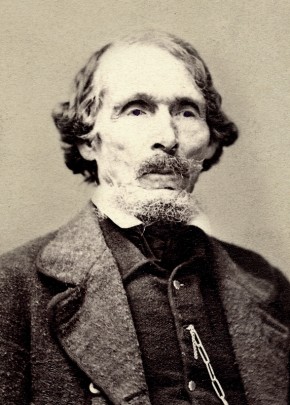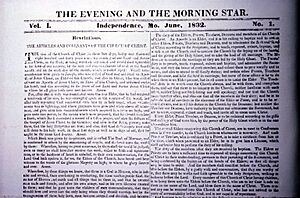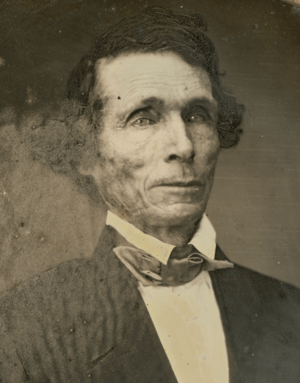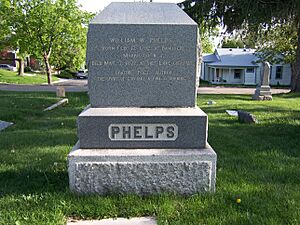W. W. Phelps (Mormon) facts for kids
Quick facts for kids W. W. Phelps |
|
|---|---|
 |
|
| Personal details | |
| Born | William Wines Phelps February 17, 1792 Hanover Township, New Jersey, US |
| Died | March 17, 1872 (aged 80) Salt Lake City, Utah Territory |
| Resting place | Salt Lake City Cemetery 40°46′37″N 111°51′29″W / 40.777°N 111.858°W |
| Occupation | Church printer |
| Title | Scribe to Joseph Smith, composer of numerous LDS hymns |
| Spouse(s) | Stella Waterman |
| Parents | Enon Phelps Mehitable Goldsmith |
William Wines Phelps (born February 17, 1792 – died March 7, 1872) was an important early leader in the Latter Day Saint movement. He was known for printing the first edition of the Book of Commandments, which became a key book for the church. He also wrote many hymns, some of which are still sung today in the Church of Jesus Christ of Latter-day Saints' (LDS Church) hymnal. Phelps worked closely with Joseph Smith, the church's founder, and later supported Brigham Young, who became the church's new president after Smith's death.
Contents
Early Life and Work
William Wines Phelps was born in Hanover Township, New Jersey, on February 17, 1792. His parents, Enon Phelps and Mehitable Goldsmith, moved their family to Homer, New York, in 1800. William was mostly self-taught, meaning he learned a lot on his own about many subjects like religion, weather, and history. He worked as an apprentice to a printer, learning how to print books and newspapers.
On April 28, 1815, he married Sally Waterman in Smyrna, New York. They had ten children together. After marrying Sally, Phelps started publishing a newspaper called the Western Courier in Homer in 1820. Later, he moved to Trumansburgh, Tompkins County, New York, where he edited another newspaper. In 1827, he moved to Canandaigua, New York, and continued to publish and edit newspapers.
Joining the Latter Day Saint Movement
Phelps bought a copy of the Book of Mormon on April 9, 1830, just three days after the Church of Christ was officially organized. He and his wife, Sally, read the book and believed it was true. Phelps met Joseph Smith on December 24, 1830, and became convinced that Smith was a prophet. On April 29, 1831, Phelps was briefly put in prison in Lyons, New York, by some people who wanted to stop him from joining the Mormons.
Kirtland, Ohio
Phelps moved to Kirtland, Ohio, in 1831. He asked Joseph Smith to seek guidance from God about what he should do. Smith received a revelation (now part of the Doctrine and Covenants) telling Phelps to join the church, preach as a missionary, and become the church's printer. He was baptized on June 16, 1831. A few days later, on June 20, he was chosen to lead the church's printing and publishing efforts.
He moved to Jackson County, Missouri, in 1832 and led the church's publishing company, W. W. Phelps & Co., in Independence, Missouri. There, he edited the Evening and Morning Star newspaper from June 1832 to 1833. He also oversaw the local schools. On July 20, 1833, while working to publish the church's Book of Commandments, a group of people attacked Phelps's home. They took printing materials, destroyed the press, and threw his family and furniture outside. Most copies of the Book of Commandments were destroyed in this attack. Phelps then moved to Clay County, Missouri.
In 1835, Phelps and his son, Waterman, traveled to Kirtland, Ohio, and stayed with Joseph Smith's family for a time. While there, Phelps worked with Joseph Smith to edit the Doctrine and Covenants for publication. He also edited and published the Latter Day Saints' Messenger and Advocate newspaper. Phelps donated money to help build the Kirtland Temple. He also helped print the first Latter Day Saint hymnal in 1835. This hymnal included his own hymn, "The Spirit of God Like a Fire Is Burning", which was sung when the Kirtland Temple was dedicated. Phelps wrote at least 35 of the 90 hymns in that first hymnal.
In 1835, Joseph Smith obtained some ancient Egyptian papyri. Phelps helped Smith by acting as his scribe during the translation of what would become the Book of Abraham in the Pearl of Great Price.
Far West, Missouri
From 1834, Phelps served as a counselor to David Whitmer in the church's leadership in Missouri. In this role, he helped establish the town of Far West, Missouri, buying land for the town using church funds. He also served as the postmaster in Far West.
Phelps faced some challenges and disagreements with church leaders in Far West. On March 10, 1838, he was removed from the church. He later provided information that led to Joseph Smith being held in jail for a time in Missouri.
Rejoining the Church
After being removed from the church, Phelps moved to Dayton, Ohio. In June 1840, he wrote a letter to Joseph Smith asking for forgiveness. Smith replied with a kind letter, welcoming him back to the church. Phelps then rejoined the church through rebaptism and moved back to Kirtland in May 1841.
Nauvoo Years
Phelps served a short mission in the eastern United States in 1841. He then moved to Nauvoo, Illinois, where he donated money to help build the Nauvoo Temple. He also worked there helping with church ceremonies. On August 27, 1841, he became Joseph Smith's clerk.
From 1843, Phelps helped Joseph Smith write many important documents during the Nauvoo period. He worked with John Taylor to edit the Times and Seasons and Nauvoo Neighbor newspapers. He also worked with Willard Richards to put together Joseph Smith's personal history, which later became History of the Church.
Phelps became a member of the Council of Fifty and the Nauvoo City Council. After the death of Joseph Smith, Phelps gave a speech at his funeral. During the time when the church was deciding who would lead next, Phelps supported Brigham Young and the Quorum of the Twelve Apostles. He used his influence to help the Twelve Apostles become the new leaders.
Moving West and Later Life
Phelps joined the Mormon Exodus across the Great Plains and settled in Salt Lake City in 1848. In November 1849, he explored southern Utah Territory with Parley P. Pratt. Phelps also served in the Utah territorial legislature from 1851 to 1857. He was also on the board of regents for the University of Deseret (now the University of Utah).
He helped create the constitution for the Provisional State of Deseret. He also wrote an almanac that recorded the activities of the Latter-day Saints in Utah for fourteen years. He helped develop the Deseret alphabet and obtained the first printing press used to print the Deseret News newspaper. He wrote poems and articles for the Deseret News, as well as essays on religious topics. He began working as a lawyer in 1851. In 1856, he wrote the LDS hymn "If You Could Hie to Kolob" for Brigham Young.
William W. Phelps died on March 7, 1872, in Salt Lake City, Utah Territory. He is buried in the Salt Lake City Cemetery. He remained a faithful member of the church until his death.
Hymns
Phelps is probably best known for the many hymns he wrote for the Latter Day Saint church. Many of these hymns are still in the current LDS Church hymnal.
- Adam-ondi-Ahman*
- Come, All Ye Saints of Zion*
- Come, All Ye Saints Who Dwell on Earth*
- Come, Let Us Sing an Evening Hymn*
- Gently Raise the Sacred Strain*
- Glorious Things Are Sung of Zion
- Hosanna Anthem
- If You Could Hie to Kolob
- Now Let Us Rejoice*
- Now We'll Sing with One Accord*
- O God, the Eternal Father*
- O Stop and Tell Me, Red Man*
- Praise to the Man
- The Spirit of God Like a Fire Is Burning*
- We're Not Ashamed to Own Our Lord*
Phelps also changed the words of popular hymns to make them unique Latter Day Saint hymns.
- Joy to the World! the Lord will Come*
- Redeemer of Israel*
- Included in the first Latter Day Saint hymnal in 1835.
See Also
- LDS fiction




